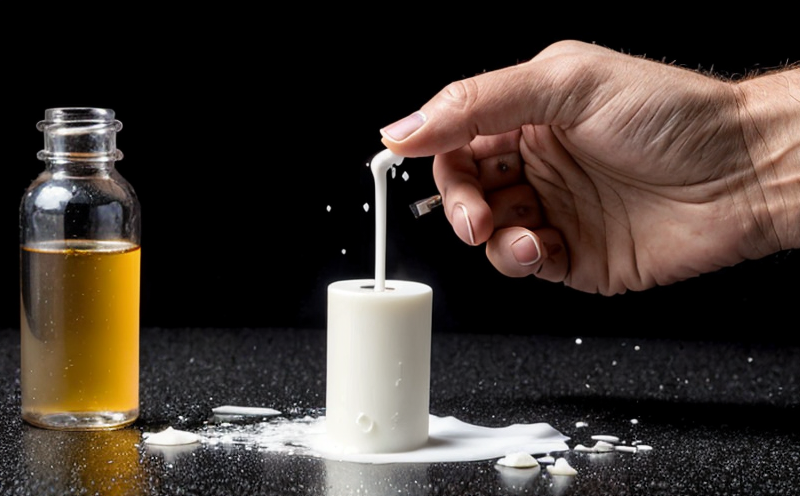USP Paddle Height Variation Testing
The United States Pharmacopeia (USP) Paddle Height Variation Testing is a critical component of pharmaceutical testing, ensuring that the dissolution and disintegration characteristics of formulations meet regulatory standards. This test evaluates the performance of tablets or pellets in an artificial gastric fluid environment to assess their ability to release active ingredients promptly.
The paddle height variation test follows USP Potency Determination General Chapter 1230, which provides specific guidance on the procedure. The primary objective is to determine whether the paddle height remains consistent throughout the dissolution process, which can impact the accuracy of the results.
The test typically involves placing a sample in a dissolution apparatus containing pH-controlled media. The paddle rotates at a specified speed (typically 100 rpm) and height, which is critical for ensuring accurate measurements. The height variation must be controlled to within ±2 mm to maintain consistency throughout the test duration.
During the testing process, it's essential to monitor several parameters:
- Paddle Speed: Typically set at 100 rpm for both dissolution and disintegration tests.
- Dissolution Medium: USP Phosphate Buffer pH 6.8 or Sodium Citrate Buffer pH 4.0, depending on the formulation.
- Temperature: Maintained at 37°C ± 1°C to simulate physiological conditions.
- Paddle Height: Must remain within ±2 mm throughout the test duration.
The paddle height variation is crucial because even small changes in this parameter can lead to significant variations in dissolution times and potencies. This makes it imperative that the testing equipment be calibrated regularly and used correctly to ensure accurate results.
Consistent paddle height ensures uniform contact between the sample and the dissolution medium, leading to reliable data. The test is particularly important for formulations where immediate drug release is critical, such as oral disintegrating tablets (ODTs) or fast-dissolving films.
The USP Paddle Height Variation Testing is not just a regulatory requirement; it plays a vital role in ensuring patient safety and efficacy. By adhering to these stringent testing protocols, pharmaceutical companies can ensure their products meet the highest standards of quality and consistency.
Industry Applications
The USP Paddle Height Variation Testing is widely used across various sectors within the pharmaceutical industry, including:
- Formulation Development: Ensures that new formulations meet dissolution and disintegration standards.
- Manufacturing Quality Control: Regularly monitors batch consistency to maintain uniform quality.
- Regulatory Compliance: Meets USP and FDA requirements for drug product testing.
- R&D Innovation: Supports the development of novel delivery systems, such as ODTs or fast-dissolving films.
The test is particularly relevant for formulations that require immediate release of active ingredients. By ensuring consistent paddle height during dissolution tests, pharmaceutical companies can enhance their drug product's performance and reliability.
Eurolab Advantages
At Eurolab, we offer comprehensive USP Paddle Height Variation Testing services that are tailored to meet the highest standards of quality assurance. Our advantages include:
- Comprehensive Expertise: Our team consists of seasoned professionals with extensive experience in pharmaceutical testing.
- State-of-the-Art Equipment: We use cutting-edge dissolution apparatus to ensure precise and accurate results.
- Rigorous Calibration: All equipment is regularly calibrated to maintain consistency and accuracy.
- Regulatory Compliance: Our services are designed to meet the strictest regulatory requirements, including USP and FDA standards.
- Consistent Results: Our testing protocols ensure that results are consistent across multiple batches.
- Expert Consultation: We provide expert guidance on formulation development and quality assurance.
- Rapid Turnaround: Our efficient processes allow for quick turnaround times without compromising the quality of our services.
By choosing Eurolab, pharmaceutical companies can ensure that their products meet the highest standards of quality and consistency, thereby enhancing patient safety and efficacy.
Why Choose This Test
The USP Paddle Height Variation Testing is essential for several reasons:
- Ensures Consistent Dissolution: By maintaining a consistent paddle height, the test ensures accurate dissolution measurements.
- Promotes Regulatory Compliance: The test is required by USP and FDA regulations to ensure drug product quality.
- Maintains Product Quality: Consistent paddle height during testing helps maintain uniform product quality across batches.
- Enhances Patient Safety: Reliable dissolution data ensures that active ingredients are released promptly, enhancing treatment efficacy.
- Innovates Formulations: The test supports the development of novel drug delivery systems by ensuring consistent performance.
- Sustains Market Reputation: Consistent and reliable testing results help maintain a positive market reputation for pharmaceutical companies.
The USP Paddle Height Variation Testing is not just a regulatory requirement; it plays a vital role in ensuring patient safety, efficacy, and the overall quality of pharmaceutical products. By choosing this test, pharmaceutical companies can ensure that their products meet the highest standards of quality and consistency.





